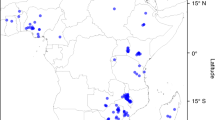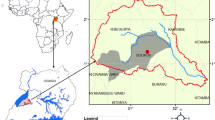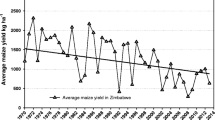Abstract
Conservation agriculture (CA) is promoted extensively to increase the productivity and environmental sustainability of maize production systems across sub-Saharan Africa and is often listed as a climate-smart agriculture (CSA) practice. However, the impacts of CA on food security, resilience/adaptive capacity and climate change mitigation are location-dependent and it is unknown whether CA can simultaneously address CSA’s multiple objectives. Here we evaluate four variations of CA: reduced tillage plus mulch (mulch), reduced tillage plus mulch and leguminous cover crop (Lablab), reduced tillage plus mulch and leguminous trees (CAWT), and reduced tillage plus mulch and nitrogen fertilizer (CA + F)—for their effect on CSA-relevant outcomes in highland Tanzania maize production. By comparison to conventional practice in the region, intensification of maize production by Lablab, CAWT, and CA + F significantly increases yields by 40, 89 and 77 %, respectively. Likewise, rainfall use efficiency was highest in these three treatments and significantly greater than conventional practices in 7 of 12 comparisons. Seasonal and annual greenhouse gas fluxes were similar across all treatments; however, yield-scaled global warming potential (Mg CO2 eq Mg grain−1) was lower in CAWT (2.1–3.1) and CA + F (1.9–2.3) than conventional practice (1.9–8.3), averaging 62 and 68 % of the emission intensity of conventional practice, respectively. The findings demonstrate that CA can deliver benefits consistent with the objectives of CSA for farmers in this region, particularly when soil nitrogen limitation is alleviated, providing other constraints to adoption are removed.


Similar content being viewed by others
References
Anderson JM, Ingram JSI (1993) Tropical soil biology and fertility: a handbook of methods, 2nd edn. C.A.B. International, Wallingford, p 221
Baker JM, Ochsner TE, Venterea RT, Griffis TJ (2007) Tillage and soil carbon sequestration—What do we really know? Agric Ecosyst Environ 118:1–5
Branca G, McCarthy N, Lipper L, Jolejole MC (2011) Climate-smart agriculture: a synthesis of empirical evidence of food security and mitigation benefits from improved cropland management., Mitigation of climate change in agriculture series 3UN FAO, Rome
Brouder SM, Gomez-Macpherson H (2014) The impact of conservation agriculture on smallholder agricultural yields: a scoping review of the evidence. Agric Ecosyst Environ 187:11–32
Burney JA, Davis SJ, Lobell DB (2010) Greenhouse gas mitigation by agricultural intensification. Proc Natl Acad Sci USA 107:12052–12057
Challinor A, Wheeler T, Garforth C et al (2007) Assessing the vulnerability of food crop systems in Africa to climate change. Clim Change 83:381–399
Climate Wizard (2014) Climate wizard. http://www.climatewizard.org. Accessed 24 Aug 2014
Dixon J, Gulliver A, Gibbon D (2001) Farming systems and poverty. FAO and World Bank, Rome
FAO (2013) Climate-smart agriculture sourcebook. FAO, Rome
FAOSTAT (2014) FAOSTAT. http://faostat.fao.org. Accessed 24 Aug 2014
Farooq M, Flower KC, Jabran K et al (2011) Crop yield and weed management in rainfed conservation agriculture. Soil Tillage Res 117:172–183
Giller KE, Witter E, Corbeels M, Tittonell P (2009) Conservation agriculture and smallholder farming in Africa: the heretics’ view. Field Crop Res 114:23–34
Girvetz EH, Zganjar C, Raber GT et al (2009) Applied climate-change analysis: the climate wizard tool. PLoS ONE 4:e8320
Grassini P, Cassman KG (2012) High-yield maize with large net energy yield and small global warming intensity. Proc Natl Acad Sci USA 109:1074–1079
Harvey CA, Chacón M, Donatti CI et al (2014) Climate-smart landscapes: opportunities and challenges for integrating adaptation and mitigation in tropical agriculture. Conserv Lett 7:77–90
SAS Institute (2008) SAS/STAT user’s guide, vers. 9.2. SAS Institute Inc., Cary
Kaczan D, Arslan A, Lipper L (2013) Climate-smart agriculture? A review of current practice of agroforestry and conservation agriculture in Malawi and Zambia ESA working paper No. 13-07, Rome, 60 pp
Kimaro AA, Timmer VR, Chamshama SOA, Mugasha AG, Kimaro DA (2008) Differential response to tree fallows in rotational woodlot systems: post-fallow maize yield, nutrient uptake, and soil nutrients. Agric Ecosyst Environ 125:73–83
Kurwakumire N, Chikowo R, Mtambanengwe F et al (2014) Maize productivity and nutrient and water use efficiencies across soil fertility domains on smallholder farms in Zimbabwe. Field Crop Res 164:136–147
Linquist B, Groenigen KJ, Adviento-Borbe MA et al (2012) An agronomic assessment of greenhouse gas emissions from major cereal crops. Glob Change Biol 18:194–209
Liyanage M de S, Danso SKA, Jayasundara HPS (1994) Biological nitrogen fixation in four Gliricidia sepium genotypes. Plant Soil 161:267–274
Mapanda F, Wuta M, Nyamangara J, Rees RM (2011) Effects of organic and mineral fertilizer nitrogen on greenhouse gas emissions and plant-captured carbon under maize cropping in Zimbabwe. Plant Soil 343:67–81
Marandu AET, Mbogoni JDJ, Ley GJ (2013) Revised fertilizer recommendations for maize and rice in the Eastern, Southern Highlands and Lake zone in Tanzania. United Republic of Tanzania, ministry of agriculture food security and cooperative, Mlingano Agricultural Research Institute, p 41
Myhre G, Shindell DT, Breon F-M et al (2013) Anthropogenic and natural radiative forcing. In: Stocker T, Qin D, Plattner G-K et al (eds) Climate change 2013 physical science basis. Contribution of working group I to fifth assessment report of the intergovernmental panel on climate change. Cambridge University Press, Cambridge, 82 pp
Neufeldt H, Jahn M, Campbell BM et al (2013) Beyond climate-smart agriculture: toward safe operating spaces for global food systems. Agric Food Secur 2:12
Paavola J (2008) Livelihoods, vulnerability and adaptation to climate change in Morogoro, Tanzania. Environ Sci Policy 11:642–654
Palm C, Blanco-Canqui H, DeClerck F et al (2014) Conservation agriculture and ecosystem services: an overview. Agric Ecosyst Environ 187:87–105
Parkin TB, Venterea RT, Hargreaves SK (2012) Calculating the detection limits of chamber-based soil greenhouse gas flux measurements. J Environ Qual 41:705–715
Powlson DS, Stirling CM, Jat ML, Gerard BG, Palm CA, Sanchez PA, Cassman KG (2014) Limited potential of no-till agriculture for climate change mitigation. Nat Clim Change 4:678–683
Rosenstock TS, Rufino MC, Butterbach-Bahl K, Wollenberg E (2013) Toward a protocol for quantifying the greenhouse gas balance and identifying mitigation options in smallholder farming systems. Environ Res Lett 8:021003
Rosenstock TS, Mpanda M, Rioux J et al (2014) Targeting conservation agriculture in the context of livelihoods and landscapes. Agric Ecosyst Environ 187:47–51
Rowhani P, Lobell DB, Linderman M, Ramankutty N (2011) Climate variability and crop production in Tanzania. Agric For Meteorol 151:449–460
Rusinamhodzi L, Corbeels M, Wijk MT et al (2011) A meta-analysis of long-term effects of conservation agriculture on maize grain yield under rain-fed conditions. Agron Sustain Dev 31:657–673
SAMPLES (2014) Standard assessment of mitigation potential and livelihoods in smallholder systems. http://www.samples.ccafs.cgiar.org. Accessed 24 Aug 2014
Schlenker W, Lobell DB (2010) Robust negative impacts of climate change on African agriculture. Environ Res Lett 5:014010
Shcherbak I, Millar N, Robertson GP (2014) Global metaanalysis of the nonlinear response of soil nitrous oxide (N2O) emissions to fertilizer nitrogen. Proc Natl Acad Sci 111:9199–9204
Sileshi GW, Akinnifesia FK, Ajayia OC, Muys B (2011) Integration of legume trees in maize-based cropping systems improves rain use efficiency and yield stability under rain-fed agriculture. Agric Water Manage 98:1364–1372
Sommer R, Thierfelder C, Tittonell P, Hove L, Mureithi J, Mikmowa S (2014) Fertilizer use should not be a fourth principle to define conservation agriculture Response to the opinion paper of Vanlauwe et al. (2014) ‘A fourth principle is required to define conservation agriculture in sub-Saharan Africa: the appropriate use of fertilizer to enhance crop productivity. Field Crop Res 169:145–148
Thierfelder C, Wall PC (2009) Effects of conservation agriculture techniques on infiltration and soil water content in Zambia and Zimbabwe. Soil Tillage Res 105:217–227
Thierfelder C, Wall PC (2010) Investigating conservation agriculture (CA) systems in Zambia and Zimbabwe to mitigate future effects of climate change. J Crop Improv 24:113–121
Thierfelder C, Cheesman S, Rusinamhodzi L (2012) A comparative analysis of conservation agriculture systems: benefits and challenges of rotations and intercropping in Zimbabwe. Field Crops Res 137:237–250
Thierfelder C, Matemba-Mutasa R, Rusinamhodzi L (2015) Yield response of maize (Zea mays L.) to conservation agriculture cropping system in Southern Africa. Soil Tillage Res 146:230–242
Van Groenigen JW, Velthof GL, Oeneme O et al (2010) Towards an agronomic assessment of N2O emissions: a case study for arable crops. Eur J Soil Sci 61:903–913
Vanlauwe B, Wendt J, Giller KE et al (2014) A fourth principle is required to define conservation agriculture in sub-Saharan Africa: the appropriate use of fertilizer to enhance crop productivity. Field Crop Res 155:10–13
Verachtert E, Govaerts B, Lichter K et al (2009) Short term changes in dynamics of C and N in soil when crops are cultivated on permanent raised beds. Plant Soil 320:281–293
Zagst L (2011) Socio-economic survey CARE-MICCA pilot project in the United Republic of Tanzania. UN FAO, Rome
Acknowledgments
We thank the farmers of the Kolero region for their collaboration. This work was primarily funded by the FAO Mitigation of Climate Change in Agriculture (MICCA) Programme and conducted in its MICCA Pilot Project in Tanzania implemented with CARE and ICRAF. We thank the CGIAR Research Program on Climate Change, Agriculture and Food Security (CCAFS) and the Standard Assessment of Mitigation Potential and Livelihoods in Smallholder Systems (SAMPLES) program, specifically, for funding scientists and laboratories that collaborated on this project.
Author information
Authors and Affiliations
Corresponding author
Rights and permissions
About this article
Cite this article
Kimaro, A.A., Mpanda, M., Rioux, J. et al. Is conservation agriculture ‘climate-smart’ for maize farmers in the highlands of Tanzania?. Nutr Cycl Agroecosyst 105, 217–228 (2016). https://doi.org/10.1007/s10705-015-9711-8
Received:
Accepted:
Published:
Issue Date:
DOI: https://doi.org/10.1007/s10705-015-9711-8




